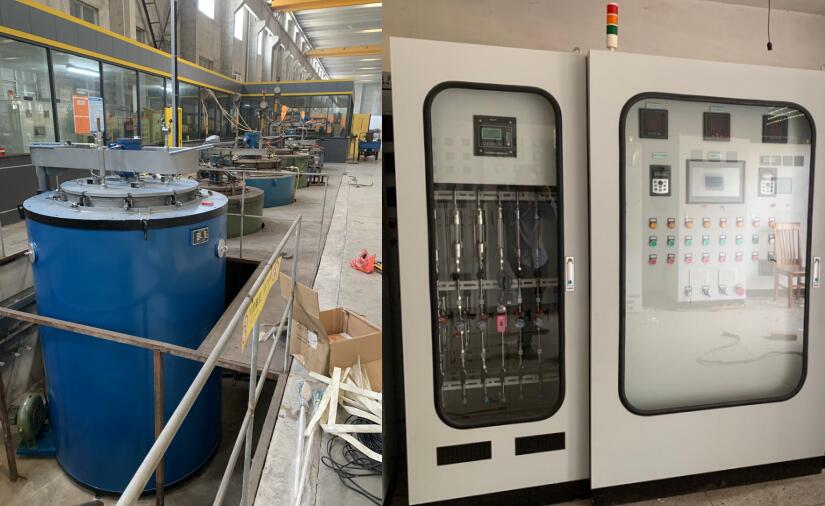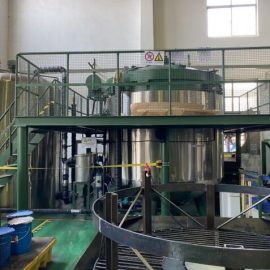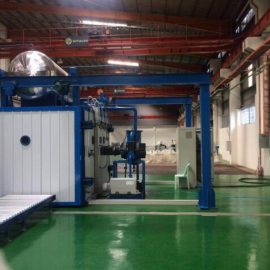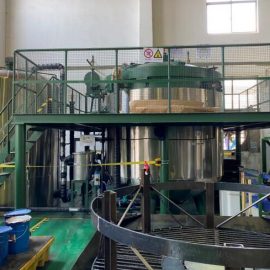Common Defects And Countermeasures Of Carburized Parts
A. Large block or network carbides appear in the carburized layer
The cause of the defect: the surface carbon concentration is too high
1. Drip carburizing, the drop volume is too large
2. Controlled atmosphere carburizing, too much enriched gas
3. Liquid carburizing, excessive cyanide content in salt bath
4. The carburized layer is air-cooled, and the cooling rate is too slow
Countermeasures:
1. Reduce the surface carbon concentration, reduce the amount of droplets during the diffusion period and appropriately increase the humidity during the diffusion period, and also appropriately reduce the amount of droplets during the carburizing period
2. Carburizing catalyst for reducing solid carburization
3. Reduction of cyanide content in liquid carburizing
4. In summer, the room temperature is too high, and the air-cooled parts can be blown to assist cooling after infiltration
5. Increase the quenching heating temperature by 50~-80℃ and prolong the holding time appropriately
6. Twice quenching or normalizing + quenching, or normalizing + high temperature tempering, then quenching and tempering
B. A large amount of retained austenite appears in the seepage layer
Defect causes:
1. Austenite is relatively stable, and the content of carbon and alloying elements in austenite is higher
2. If the tempering is not timely, the austenite is thermally stabilized
3. Cooling too slowly after tempering
Countermeasures:
1. The surface carbon concentration should not be too high
2. Reduce the direct quenching or reheat quenching temperature, and control the level of ferrite in the core to be less than or equal to level 3
3. Quick cooling after low temperature tempering
4. It can be reheated and quenched, cold treated, or re-quenched after high temperature tempering
C. Surface Decarburization
Defect causes:
1. In the late stage of gas carburization, the carbon potential of furnace gas is low
2. After solid carburizing, the cooling rate is too slow
3. Air cooling time is too long after carburizing
4. Unprotected cooling in cooling wells
5. Air furnace heating and quenching without protective gas
6. Salt bath furnace heating and quenching, salt bath deoxidization is not complete
Countermeasures:
1. Infiltrate in a medium with suitable carbon potential
2. Shot peening after quenching
3. Grinding allowance, larger pieces are allowed to have a certain decarburization layer (≤0.02mm)
D. Troostite structure (black structure) appears after quenching of carburized layer
Causes of defects: high oxygen content in the carburizing medium: oxygen diffuses to the grain boundaries to form oxides of Cr, Mn and Si, which depletes the alloy elements and reduces the hardenability
Countermeasures:
1. Control furnace gas medium composition to reduce oxygen content
2. Remedy with shot peening
3. Improve the cooling capacity of the quenching medium
E. Too much ferrite in the core, resulting in insufficient hardness
Defect causes:
1. low quenching temperature
2. Insufficient time for reheating and quenching, and insufficient cooling rate for quenching
3. Undissolved ferrite in the heart
4. Austenite decomposition products in the core
Countermeasures:
1. Reheat and quench according to the normal process
2. Properly increase the quenching temperature and prolong the holding time
F. Insufficient depth of carburized layer
Defect causes:
1. Low furnace temperature and short holding time
2. low concentration of osmotic agent
3. Furnace leaks
4. The salt bath carburizing composition is abnormal
5. Too much furnace load
6. There is oxide scale or carbon deposits on the surface of the workpiece
Countermeasures:
1. According to the reasons, adjust the carburizing temperature, time, dripping amount and the sealing performance of the furnace
2. Strengthening new salt identification and inspection of working conditions
3. Parts should be cleaned
4. If the infiltration layer is too thin, infiltration can be supplemented. The infiltration rate is 1/2 of normal carburization, about 0.1mm/h.
G. Uneven depth of infiltration layer
Defect causes:
1. Uneven furnace temperature
2. Poor atmosphere circulation in the furnace
3. Carbon black deposits on the surface
4. Large temperature difference in solid carburizing box and uneven catalyst infiltration
5. There are rust spots, oil stains, etc. on the surface of the parts
6. Inconsistent surface roughness of parts
7. Uneven density of hanging parts
8. The raw material has a banded tissue
Countermeasures:
1. Strictly clean parts before carburizing
2. Clean up carbon deposits in the furnace
3. When the parts are clamped, they should be evenly distributed and the gaps should be equal in size
4. Check furnace temperature uniformity frequently
5. Raw materials must not have banded tissue
6. Frequently check furnace temperature, furnace gas and furnace loading
H. Low surface hardness
Defect causes:
1. Low surface carbon concentration
2. surface retained austenite
3. troostite structure on the surface
4. The quenching temperature is high, the amount of dissolved austenite carbon is large, and a large amount of retained austenite is formed after quenching
5. The quenching heating temperature is low, the amount of carbon dissolved in the austenite is not enough, and the quenched martensite has low carbon content
6. Tempering temperature too high
Countermeasures:
1. Low carbon concentration, can be infiltrated
2. There is a lot of retained austenite, which can be tempered at high temperature and then heated and quenched
3. With trosteite structure, it can be reheated and quenched
4. Strict heat treatment process discipline
I. Surface Corrosion and Oxidation
Defect causes:
1. Penetrant impure water, sulfur and sulfate
2. Gas carburizing furnace gas leakage When solid carburizing, the infiltrating agent melts on the surface of the workpiece, and after the liquid carburizing, the surface of the workpiece sticks to residual salt
3. High temperature out of the oven, air cooling protection is not enough
4. The salt furnace is not completely calibrated, the air furnace is heated without a protective atmosphere, and it is not cleaned in time after quenching
5. The surface of the part is not clean
Countermeasures:
1. Strictly control carburizing agent and salt bath composition
2. Check equipment seals frequently
3. Clean and clean the surface of parts in time
4. Strictly implement process discipline
J. Cracked carburized parts
Defect causes:
1. The cooling rate is too slow, and the tissue transformation is uneven
2. After the alloy steel is infiltrated and cooled in air, a layer of untransformed austenite remains under the surface layer of tortenite. When it is subsequently cooled or placed at room temperature, it transforms into martensite, the specific volume increases, and tensile stress occurs.
3. During the first quenching, the cooling rate is too fast or the shape of the workpiece is complicated]
4. The material contains too many trace elements (Mo, B) that improve hardenability, etc.
Countermeasures:
1. After infiltration, the cooling rate is slowed down, so that the infiltration layer is completely eutectoid transformed during the cooling process
2. After infiltration, the cooling rate is accelerated to obtain martensite + retained austenite. Tensile stress due to tissue transformation in the relaxed inner layer
3. Quenching cracking should slow down the cooling rate, contain trace elements for process test, or increase the temperature of the quenching medium
K. Hydrogen Embrittlement of High Alloy Steels
Defect causes:
1. Too much hydrogen in furnace gas
2. Carburizing temperature is too high for hydrogen diffusion
3. Direct quenching after infiltration, the hydrogen does not have time to precipitate and exists in the steel in a supersaturated state
Countermeasures:
1. Slow cooling after carburizing
2. After direct quenching, rapidly tempered above 250ºC
3. Before the parts are released from the furnace, stop supplying the infiltrating agent, and directly quench after passing in nitrogen to discharge hydrogen.
L. Low carbon concentration in the carburized layer
Defect causes:
1. The carbon potential in the furnace is low, the temperature is low, the amount of dripping is small, and the furnace leaks.
2. Carbon black is formed on the surface of the workpiece or covered with carbon black, and the furnace loading is too much
3. The furnace atmosphere is not uniform, and the furnace pressure is too low, causing the furnace to partially cause dead ends.
4. The distance between the workpieces is too small, and the furnace cycle is not smooth
5. Decarburization on cooling after infiltration
Countermeasures:
1. When carburizing, always check the furnace temperature and the amount of infiltrating agent drop
2. Pay attention to furnace gas and furnace pressure
3. Prevent furnace leaks and fans from stalling and reversing
4. The distance between workpieces is greater than 1cn
5. Often burn carbon black, clean the carbon deposits in the furnace, infiltrate into the cooling well for cooling, pour kerosene or methanol into the well for protection
M. Carburized layer is too thick
Defect causes:
1. Carburizing temperature is too high, holding time is too long
2. The amount of dripping is too large, and the carbon potential in the furnace is high
3. Sample inspection is not allowed
Countermeasures:
1. Take technical measures for the reasons
2. The seepage layer exceeds the upper limit of the drawing and is unqualified, but if the difference from the drawing is 0.05mm, it can be arbitrated or applied for reuse
N. Excessive distortion of carburized parts
Defect causes:
1. Improper selection of furnace method or fixture during carburizing
2. Carburizing temperature is too high, furnace gas, furnace pressure is uneven and unstable
3. Direct quenching temperature is too high
4. Inappropriate arrangement of two quenching
5. Improper heating method, improper quenching agent and cooling method
6. Too many times of quenching and rework
7. The concentration and depth of the carburized layer on the part are not uniform, causing irregular warpage during quenching
8. The shape of the workpiece is complex, the wall thickness is uneven, some surfaces are carburized, and some surfaces are not carburized or less carburized
Countermeasures:
1. The long rod-shaped parts should be hung vertically, the flat parts should be placed flat, the parts should be stable on the fixture and not subject to prestress, the operation of the furnace should be stable, and the furnace temperature should be appropriate.
2. Direct quenching should be pre-cooled, try to use primary quenching instead of secondary quenching, and choose heat treatment process correctly
3. Leave a machining allowance in advance
O. Carburizing rate is very slow
Defect causes:
1. temperature too low
2. Too much penetrating agent, the surface area of the parts is charcoal
3. Excessive sulfur content in the penetrant
4. The fan bearings are lubricated with MoS2, and the lubricating oil enters the furnace to increase the sulfur
5. Fan bearing leaks, oxygen enters the furnace
6. Fan shaft cooling water seeps into the furnace
countermeasures
Take appropriate action against defects
P. Surface peeling of carburized parts after quenching
Defect causes:
1. Solid carburizing agent activity is too strong
2. The carburizing temperature is too high, a large number of carbon atoms penetrate into the surface of the workpiece and it is too late to diffuse, and the transition is not good, resulting in an excessively high surface carbon concentration
Countermeasures:
1. Heat the high carbon potential part in a protective atmosphere (carbon potential (volume fraction) of 0.8%) for 2~4h to reduce the surface carbon concentration
2. This piece can also be heated to 920~940ºC in soda and charcoal with a mass fraction of 3%~5%, and kept for 2~4h to reduce the surface carbon concentration
Q. Vitreous bulge on part
Defect causes:
1. During solid carburizing, the carburizing process is caused by the mass fraction of SiO2 exceeding 2%
2. The high temperature of SiO2 and the action of Na2CO3 generate glassy substances that adhere to the surface of the workpiece and form bulges
Countermeasures:
1. When solid carburizing, the infiltrating agent should be pure
2. The old carburizing agent is thoroughly screened to remove dust
3. Removal of sand and gravel in penetrant and refractory clay for sealing
R. Abnormal structure of carburized parts (free ferrite, free cementite or reticulated ferrite around secondary cementite)
Defect causes:
1. Due to the high oxygen content in steel and carburizing medium, soft spots appear during quenching and wear resistance is reduced
2. Carburizing agent should be dried to remove moisture
Countermeasures:
1. Properly increase the quenching temperature and prolong the holding time to homogenize the structure
2. Use quenching medium with high quenching intensity
S. Overheating
Defect causes:
1. Overpotential during carburization or overpotential during quenching and heating causes grain growth and brittleness to increase
2. When carburizing is over, not only the carbon content of the surface layer increases, but also the carbides increase, resulting in ledeburite
Countermeasures:
1. Use normalizing to refine grains
2. Salt furnace heating and quenching, the workpiece can not be close to the electrode
3. Check whether the instrument is malfunctioning

Heat-Treated Refractory Fibers Characteristics And Classification Trolley Annealing Furnaces For Pressure Vessel Components The Principle And Classification Of Quenching Process




Contact us
Your email address will not be published. Required fields are marked *